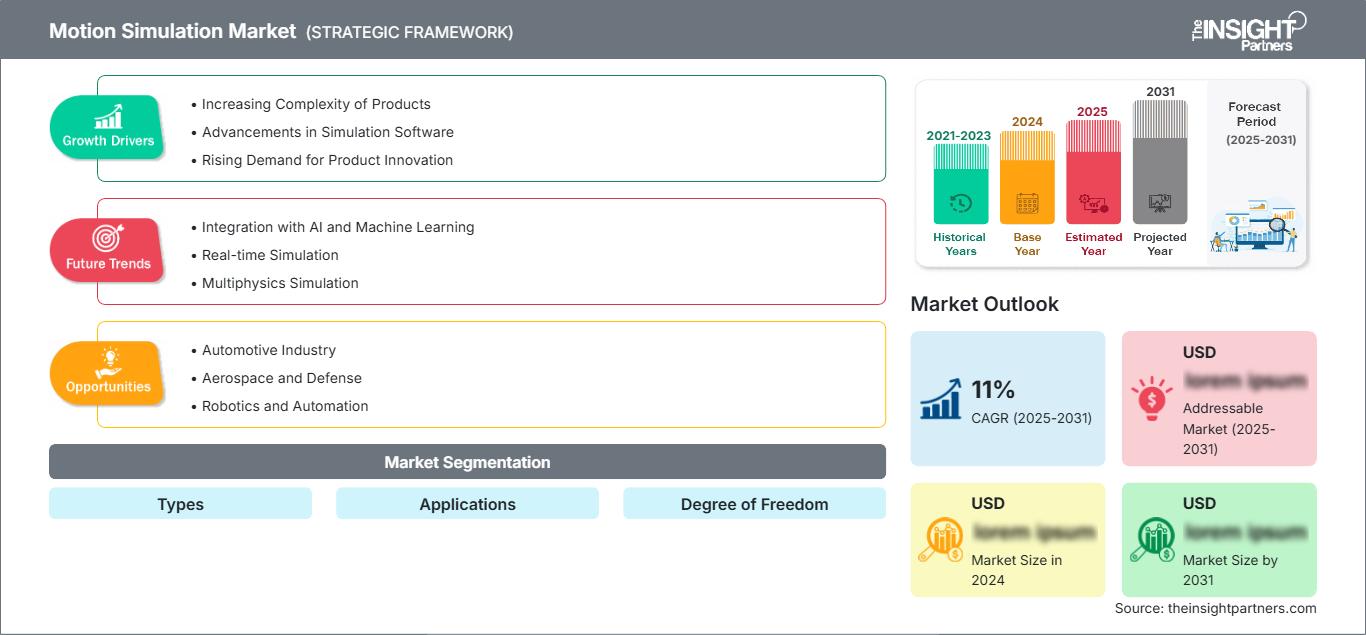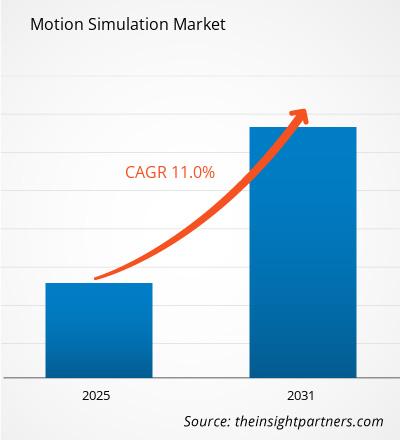Si prevede che il mercato della simulazione del movimento registrerà un CAGR dell'11% dal 2025 al 2031, con una dimensione del mercato in espansione da XX milioni di dollari nel 2024 a XX milioni di dollari entro il 2031.
Il rapporto è segmentato in base a tipologie, applicazioni e grado di libertà. L'analisi globale è ulteriormente suddivisa a livello regionale e per i principali paesi. Il rapporto offre il valore in dollari USA per l'analisi e i segmenti sopra indicati.
Scopo del rapporto
Il rapporto "Motion Simulation Market" di The Insight Partners mira a descrivere il panorama attuale e la crescita futura, i principali fattori trainanti, le sfide e le opportunità. Ciò fornirà spunti a vari stakeholder aziendali, come:
- Fornitori/produttori di tecnologia: per comprendere le dinamiche di mercato in evoluzione e conoscere le potenziali opportunità di crescita, consentendo loro di prendere decisioni strategiche informate.
- Investitori: per condurre un'analisi completa delle tendenze in merito al tasso di crescita del mercato, alle proiezioni finanziarie del mercato e alle opportunità esistenti lungo la catena del valore.
- Organismi di regolamentazione: per regolamentare le politiche e le attività di controllo nel mercato con l'obiettivo di ridurre al minimo gli abusi, preservare la fiducia degli investitori e sostenere l'integrità e la stabilità del mercato.
Tipi di segmentazione del mercato della simulazione del movimento
Applicazioni
Grado di libertà
Geografia
- Nord America
- Europa
- Asia-Pacifico
- America meridionale e centrale
- Medio Oriente e Africa
Potrai personalizzare gratuitamente qualsiasi rapporto, comprese parti di questo rapporto, o analisi a livello di paese, pacchetto dati Excel, oltre a usufruire di grandi offerte e sconti per start-up e università
Mercato della simulazione del movimento: Approfondimenti strategici

-
Ottieni le principali tendenze chiave del mercato di questo rapporto.Questo campione GRATUITO includerà l'analisi dei dati, che vanno dalle tendenze di mercato alle stime e alle previsioni.
Fattori di crescita del mercato della simulazione del movimento
- Crescente complessità dei prodotti: con l'aumentare della complessità dei prodotti, diventa essenziale una simulazione accurata del loro movimento e delle loro prestazioni.
- Progressi nel software di simulazione: lo sviluppo di software di simulazione sofisticati con potenti funzionalità sta guidando la crescita del mercato.
- Crescente domanda di innovazione di prodotto: per rimanere competitive, le aziende stanno investendo in tecnologie di simulazione per accelerare lo sviluppo e l'innovazione dei prodotti.
Tendenze future del mercato della simulazione del movimento
- Integrazione con intelligenza artificiale e apprendimento automatico: intelligenza artificiale e apprendimento automatico miglioreranno la precisione e l'efficienza della simulazione, consentendo analisi predittive e ottimizzazione.
- Simulazione in tempo reale: la simulazione in tempo reale faciliterà rapide iterazioni di progettazione e test virtuali, riducendo il time-to-market.
- Simulazione multifisica: la combinazione di più fenomeni fisici in un'unica simulazione fornirà una comprensione più completa del comportamento del prodotto.
Opportunità di mercato per la simulazione del movimento
- Industria automobilistica: la simulazione del movimento è fondamentale per la progettazione e il collaudo dei veicoli, dalle prestazioni del motore ai sistemi di guida autonoma.
- Aerospaziale e difesa: la simulazione del movimento di aerei, missili e satelliti è essenziale per garantire sicurezza e prestazioni.
- Robotica e automazione: la simulazione del movimento svolge un ruolo chiave nello sviluppo e nell'ottimizzazione di robot e sistemi automatizzati.
Approfondimenti regionali sul mercato della simulazione del movimento
Le tendenze regionali e i fattori che influenzano il mercato della simulazione del movimento durante il periodo di previsione sono stati ampiamente spiegati dagli analisti di The Insight Partners. Questa sezione illustra anche i segmenti e la geografia del mercato della simulazione del movimento in Nord America, Europa, Asia-Pacifico, Medio Oriente e Africa, America meridionale e centrale.
Ambito del rapporto di mercato sulla simulazione del movimento
| Attributo del rapporto | Dettagli |
|---|---|
| Dimensioni del mercato in 2024 | US$ XX million |
| Dimensioni del mercato per 2031 | US$ XX Million |
| CAGR globale (2025 - 2031) | 11% |
| Dati storici | 2021-2023 |
| Periodo di previsione | 2025-2031 |
| Segmenti coperti |
By TipiBy ApplicazioniBy Grado di libertàBy Geografia
|
| Regioni e paesi coperti |
Nord America
|
| Leader di mercato e profili aziendali chiave |
|
Densità degli operatori del mercato della simulazione del movimento: comprendere il suo impatto sulle dinamiche aziendali
Il mercato della simulazione del movimento è in rapida crescita, trainato dalla crescente domanda degli utenti finali, dovuta a fattori quali l'evoluzione delle preferenze dei consumatori, i progressi tecnologici e una maggiore consapevolezza dei vantaggi del prodotto. Con l'aumento della domanda, le aziende stanno ampliando la propria offerta, innovando per soddisfare le esigenze dei consumatori e sfruttando le tendenze emergenti, alimentando ulteriormente la crescita del mercato.

- Ottieni il Mercato della simulazione del movimento Panoramica dei principali attori chiave
Punti di forza
- Copertura completa: il rapporto analizza in modo esaustivo prodotti, servizi, tipologie e utenti finali del mercato della simulazione del movimento, offrendo una panoramica olistica.
- Analisi degli esperti: il rapporto è redatto sulla base della conoscenza approfondita di esperti e analisti del settore.
- Informazioni aggiornate: il rapporto garantisce la pertinenza aziendale grazie alla copertura di informazioni e tendenze dei dati recenti.
- Opzioni di personalizzazione: questo rapporto può essere personalizzato per soddisfare le esigenze specifiche del cliente e adattarsi in modo appropriato alle strategie aziendali.
Il rapporto di ricerca sul mercato della simulazione del movimento può quindi contribuire a guidare il percorso di decodificazione e comprensione dello scenario del settore e delle prospettive di crescita. Sebbene possano esserci alcune preoccupazioni valide, i vantaggi complessivi di questo rapporto tendono a superare gli svantaggi.
- Analisi storica (2 anni), anno base, previsione (7 anni) con CAGR
- Analisi PEST e SWOT
- Valore/volume delle dimensioni del mercato - Globale, Regionale, Nazionale
- Industria e panorama competitivo
- Set di dati Excel
Report recenti
Testimonianze
Motivo dell'acquisto
- Processo decisionale informato
- Comprensione delle dinamiche di mercato
- Analisi competitiva
- Analisi dei clienti
- Previsioni di mercato
- Mitigazione del rischio
- Pianificazione strategica
- Giustificazione degli investimenti
- Identificazione dei mercati emergenti
- Miglioramento delle strategie di marketing
- Aumento dell'efficienza operativa
- Allineamento alle tendenze normative






















 Ottieni un campione gratuito per - Mercato della simulazione del movimento
Ottieni un campione gratuito per - Mercato della simulazione del movimento